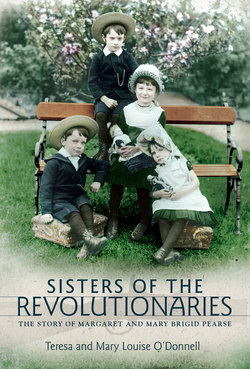Читать книгу Sisters of the Revolutionaries - Teresa O’Donnell - Страница 8
На сайте Литреса книга снята с продажи.
ОглавлениеIntroduction
This book focuses on the lives of Margaret and Mary Brigid Pearse, sisters of Patrick and Willie who were executed for their roles in the Easter Rising of 1916. The Pearse sisters have long been overshadowed by their famous brothers but they too travelled interesting paths in life. Margaret was a teacher, Irish language activist and politician who shared Patrick’s educational vision for a bilingual education system and his political vision of an independent Irish nation. Mary Brigid was a musician, teacher, actress and author of short stories, children’s stories, and dramas, but did not agree with her family’s political activism. Margaret and Mary Brigid never enjoyed a close relationship like Patrick and Willie; however, they both shared a deep affection for their brothers.
The Pearse sisters have been accorded little attention in the biographies of Patrick. Possible explanations for their neglect may be the lack of source material and the perception that they played only a peripheral role in the history of the Pearse family. Yet Margaret and Mary Brigid, along with Willie, played an integral part in the creation of the complex, multifaceted man that was Patrick Pearse. Indeed, Margaret and her mother were largely responsible for contributing to, and perpetuating, the myth or cult of Patrick Pearse after his execution.
Until Róisín Ní Ghairbhí’s recent publication on Willie, little was known about his character, his artistic ability or his commitment to Irish cultural movements in the late nineteenth and early twentieth centuries. It seems an opportune time to illuminate the lives of the other Pearse siblings and finally remove them from the shadow of their famous brothers. Unfortunately, there is a dearth of information on Margaret and Mary Brigid. Consequently, to piece together the story of their lives, we have relied heavily on extant correspondence and writings of the two sisters held at the Pearse Archive in Kilmainham Gaol, Patrick Pearse’s own writings and letters, in particular his unfinished autobiography, and newspaper articles and references to the sisters in the collections of various archives and museums.
An examination of the lives of Mary Brigid and Margaret provides a new perspective on how Patrick managed to realise so many of his pedagogical and cultural ambitions, namely through the unstinting support of his parents and siblings. One of the recurring themes of this book is the profound influence that the stable and loving home life enjoyed by the Pearse siblings in their childhood had on their adult lives. Their father, James, often wrote of his desire to create a happy home.1 Patrick, in his autobiography, frequently spoke about his wish to always be ‘at home’2 and Mary Brigid entitled her book The Home-Life of Pádraig Pearse. For Patrick, Willie, Margaret and Mary Brigid, their home was the centre of their lives, the foundation on which everything was built and from which everything could be accomplished. To understand any of the Pearse children, particularly Patrick, one must consider the family that nurtured and shaped them.
From their childhood through to adolescence and adulthood, the Pearse siblings supported each other’s projects. Mary Brigid and Willie founded the Leinster Stage Society and Margaret assisted in the foundation of Patrick’s school, St Enda’s/Scoil Éanna, where she taught French and religious studies. The active participation of both sisters in various associations and projects connected with Patrick and Willie was facilitated by the financial security that their father provided for them before his death. The Pearse sisters were from a typical middle-class background; they were well-educated and instilled with the confidence to pursue writing or educational projects, and were not compelled to eke out a living through paid employment. They had the potential to achieve so much, but their lives were transformed after Easter 1916.
The sisters’ responses to their brothers’ actions contrasted greatly. Margaret described the Rising as ‘tragic but glorious’3 and from 1916 until her death in 1968, she attended State and public ceremonies in honour of her brothers, actively promoted the Irish language, and served as a Fianna Fáil politician. Mary Brigid, who was of a ‘delicate’ disposition, struggled to come to terms with her brothers’ deaths. After the Rising, Mary Brigid opted to steer clear of their political legacy and focus instead on her literary career. She found it difficult, however, to carve out an identity and a career for herself which was separate from her family name.
This book is the first full-length attempt to engage with the lesser-known Pearse siblings and it complements existing research on the Pearse family. The study provides a fascinating insight into Margaret and Mary Brigid’s relationships with their brothers, but also the poignant disintegration of their own relationship following the death of their mother in 1932.
Teresa and Mary Louise O’Donnell
January 2017
